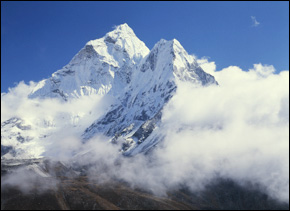Third Pole Meltdown: Himalayan Glaciers Are Diminishing at Faster Rates
 Black carbon soot clouds and rising temperatures are causing Himalayan Glaciers to melt at an “alarming” rate, news reports announced this past week.
Black carbon soot clouds and rising temperatures are causing Himalayan Glaciers to melt at an “alarming” rate, news reports announced this past week.
“Glaciers in the Himalaya are receding faster than in any other part of the world and, if the present rate continues, the likelihood of them disappearing by the year 2070 and perhaps sooner is very high if the Earth keeps warming at the current rate,” according to a 2007 Intergovernmental Panel on Climate Change (IPCC) report.
Melting glaciers can generate massive floods downstream, known as glacial lake outburst floods (GLOFs), which are happening more frequently in recent years, according to scientists.
“Twenty-one GLOF events have adversely affected Nepalese territory in the recent past and to date over 200 potentially dangerous glacial lakes have been documented across the Himalayan region,” according to the “Impact of Climate Change on Himalayan Glaciers and Glacial Lakes” report (2007).
Earlier this week a three-day conference, “Climate Change, Glacial Retreat and Livelihoods,” highlighted recent negative developments in the Kashmir region. Kashmir is shared by India, Pakistan and China.
“The need of the hour is to have a coordinated effort to address the issue of climate change at the regional and local levels in Jammu and Kashmir,” said The Kashmir University Vice-Chancellor, Professor Riyaz Punjabi on Monday, reported by the News Agency of Kashmir.
Studies presented at the conference revealed that Kolahoi, the area’s biggest glacier, has melted by 4.44 square miles (11.5 square kilometers) from about five square miles (13 square kilometers) in the past 40 years.
Glaciers along the Tibetan Plateau and Himalayas, including Kolahoi, feed out into a system of rivers that are used for economic, social and religious reasons by people throughout the region.
Changing hydrology could have political and religious consequences in the region, especially for India. GLOFs could result in floods along historically tense borderlines in the northeast with China and in the northwest with Pakistan.
Already the Siachen Glacier, located on the U.N.-designated “Line of Control” between India and Pakistan, has melted to half its original size, the report states. Indian and Pakistani military forces are permanently stationed in the region and have engaged in on-again, off-again conflict since 1984.
Meanwhile, China and India are slated to sign an agreement this month to further border research on the glacial melting, according to CNN reports.









when did this occur? did it happen on october 14th or is just the date it got posted